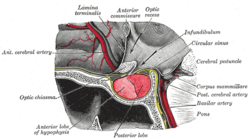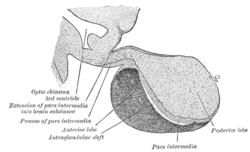Pituitary gland
| Pituitary gland | |
|---|---|
 |
|
| Located at the base of the brain, the pituitary gland is protected by a bony structure called the sella turcica(also known as turkish saddle)of the sphenoid bone. | |
 |
|
| Median sagittal through the hypophysis of an adult monkey. Semidiagrammatic. | |
| Latin | hypophysis, glandula pituitaria |
| Gray's | subject #275 1275 |
| Artery | superior hypophyseal artery, infundibular artery, prechiasmal artery, inferior hypophyseal artery, capsular artery, artery of the inferior cavernous sinus[1] |
| Precursor | neural and oral ectoderm, including Rathke's pouch |
| MeSH | Pituitary+Gland |
| Dorlands/Elsevier | Pituitary gland |
The pituitary gland, or hypophysis, is an endocrine gland about the size of a pea. It is a protrusion off the bottom of the hypothalamus at the base of the brain, and rests in a small, bony cavity (sella turcica) covered by a dural fold (diaphragma sellae). The pituitary fossa, in which the pituitary gland sits, is situated in the sphenoid bone in the middle cranial fossa at the base of the brain.
The pituitary gland secretes hormones regulating homeostasis, including tropic hormones that stimulate other endocrine glands. It is functionally connected to the hypothalamus by the median eminence.
Contents |
Sections
Located at the base of the brain, the pituitary is linked in function to the hypothalamus. It is composed of two lobes: the adenohypophysis and neurohypophysis. The adenohypophysis, also referred to as the anterior pituitary is divided into anatomical regions known as the pars tuberalis, pars intermedia, and pars distalis. The neurohypophysis, also referred to as the posterior pituitary. The pituitary is functionally linked to the hypothalamus by the pituitary stalk, whereby hypothalamic releasing factors are released and, in turn, stimulate the release of pituitary hormones.
Anterior pituitary (Adenohypophysis)
The anterior pituitary synthesizes and secretes important endocrine hormones, such as ACTH, TSH, PRL, GH, endorphins, FSH, and LH. These hormones are released from the anterior pituitary under the influence of hypothalamus. Hypothalamic hormones are secreted to the anterior lobe by way of a special capillary system, called the hypothalamic-hypophyseal portal system. The anterior pituitary develops from a depression in the dorsal wall of the pharynx (stomodial part) known as Rathke's pouch.
Posterior pituitary (Neurohypophysis)
The hormones secreted by the posterior pituitary are
- Oxytocin, most of which is released from the paraventricular nucleus in the hypothalamus
- Antidiuretic hormone (ADH, also known as vasopressin and AVP, arginine vasopressin), the majority of which is released from the supraoptic nucleus in the hypothalamus
Oxytocin is one of the few hormones to create a positive feedback loop. For example, uterine contractions stimulate the release of oxytocin from the posterior pituitary, which, in turn, increases uterine contractions. This positive feedback loop continues throughout labor.
Intermediate lobe
There is also an intermediate lobe in many animals. For instance, in fish, it is believed to control physiological color change. In adult humans, it is just a thin layer of cells between the anterior and posterior pituitary. The intermediate lobe produces melanocyte-stimulating hormone (MSH), although this function is often (imprecisely) attributed to the anterior pituitary.
Functions
The pituitary hormones help control some of the following body processes:
- Growth
- Blood pressure
- Some aspects of pregnancy and childbirth including stimulation of uterine contractions during childbirth
- Breast milk production
- Sex organ functions in both women and men
- Thyroid gland function
- The conversion of food into energy (metabolism)
- Water and osmolarity regulation in the body
Pathology
Disorders involving the pituitary gland include:
| Condition | Direction | Hormone |
| Acromegaly | overproduction | growth hormone |
| Growth hormone deficiency | underproduction | growth hormone |
| Syndrome of inappropriate antidiuretic hormone | overproduction | vasopressin |
| Diabetes insipidus | underproduction | vasopressin |
| Sheehan syndrome | underproduction | any pituitary hormone |
| Pituitary adenoma | overproduction | any pituitary hormone |
| Hypopituitarism | underproduction | any pituitary hormone |
Additional images
See also
- Head and neck anatomy
References
- ↑ Gibo H, Hokama M, Kyoshima K, Kobayashi S (1993). "[Arteries to the pituitary]". Nippon Rinsho 51 (10): 2550–4. PMID 8254920.
External links
- NeuroNames hier-382
- Histology at BU 14201loa
- The Pituitary Gland, from the UMM Endocrinology Health Guide
- Oklahoma State, Endocrine System
- Pituitary apoplexy mimicking pituitary abscess
|
||||||||
|
|||||||||||||||||||
|
||||||||||||||